Education and Sustainable Development
VerifiedAdded on 2023/06/09
|16
|3864
|198
AI Summary
The report gives an insight into how education acts as the key to sustainable development. The report commences with a discussion on the role of education as the key to the sustainable development. It also discusses about how education drove history and the factors that enabled and disenabled education. There is a section discussing about the role played by the foreign donors. There is also discussion of the objectives of the education for sustainable development(ESD). The report also discusses about the achievement of education for sustainable development in the last decade . There is also discussion about the alignment of ESD and the economic growth with the sustainable development. One can also find why a better pedagogy is necessary for ESD and how it helps in the attainment of the sustainable developmental goals.
Contribute Materials
Your contribution can guide someone’s learning journey. Share your
documents today.
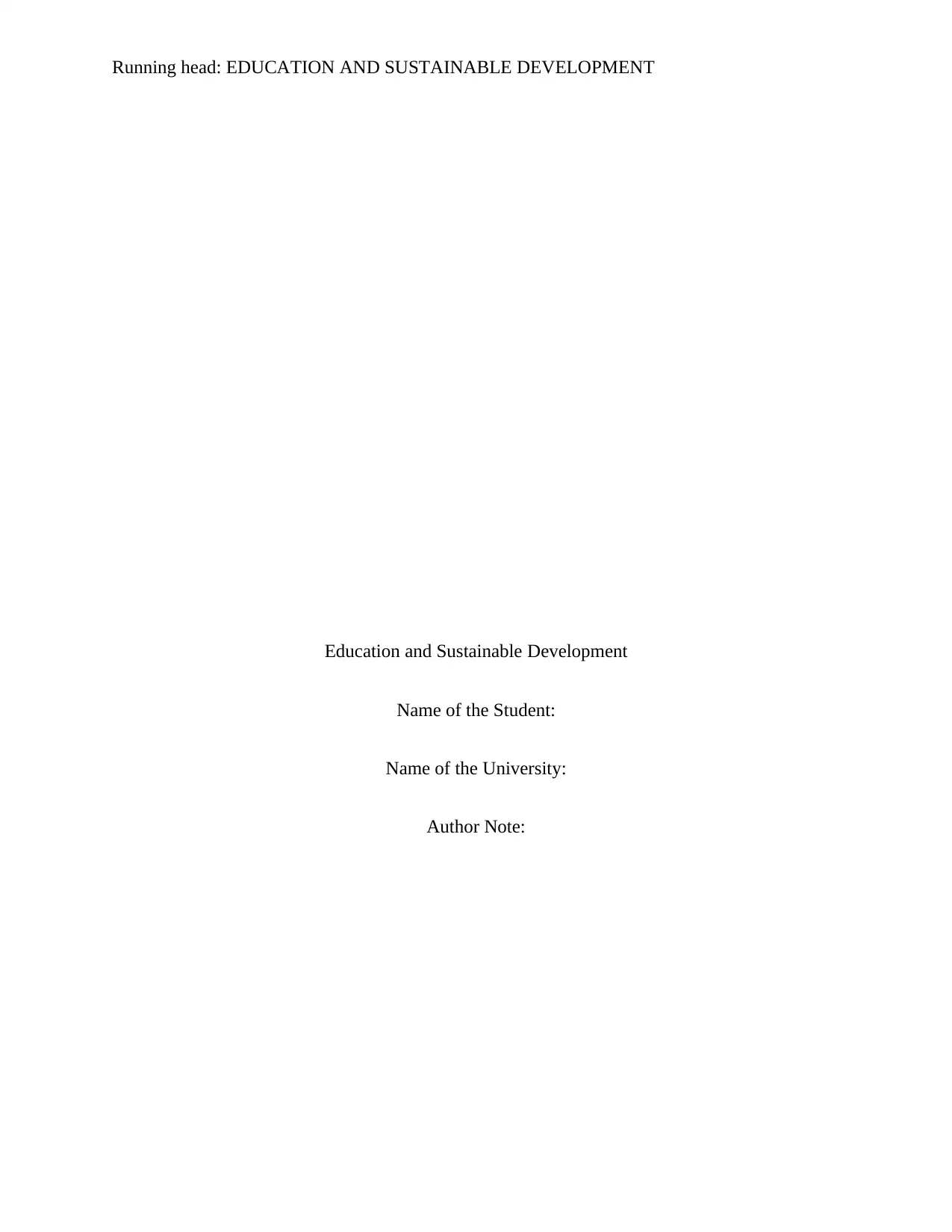
Running head: EDUCATION AND SUSTAINABLE DEVELOPMENT
Education and Sustainable Development
Name of the Student:
Name of the University:
Author Note:
Education and Sustainable Development
Name of the Student:
Name of the University:
Author Note:
Secure Best Marks with AI Grader
Need help grading? Try our AI Grader for instant feedback on your assignments.
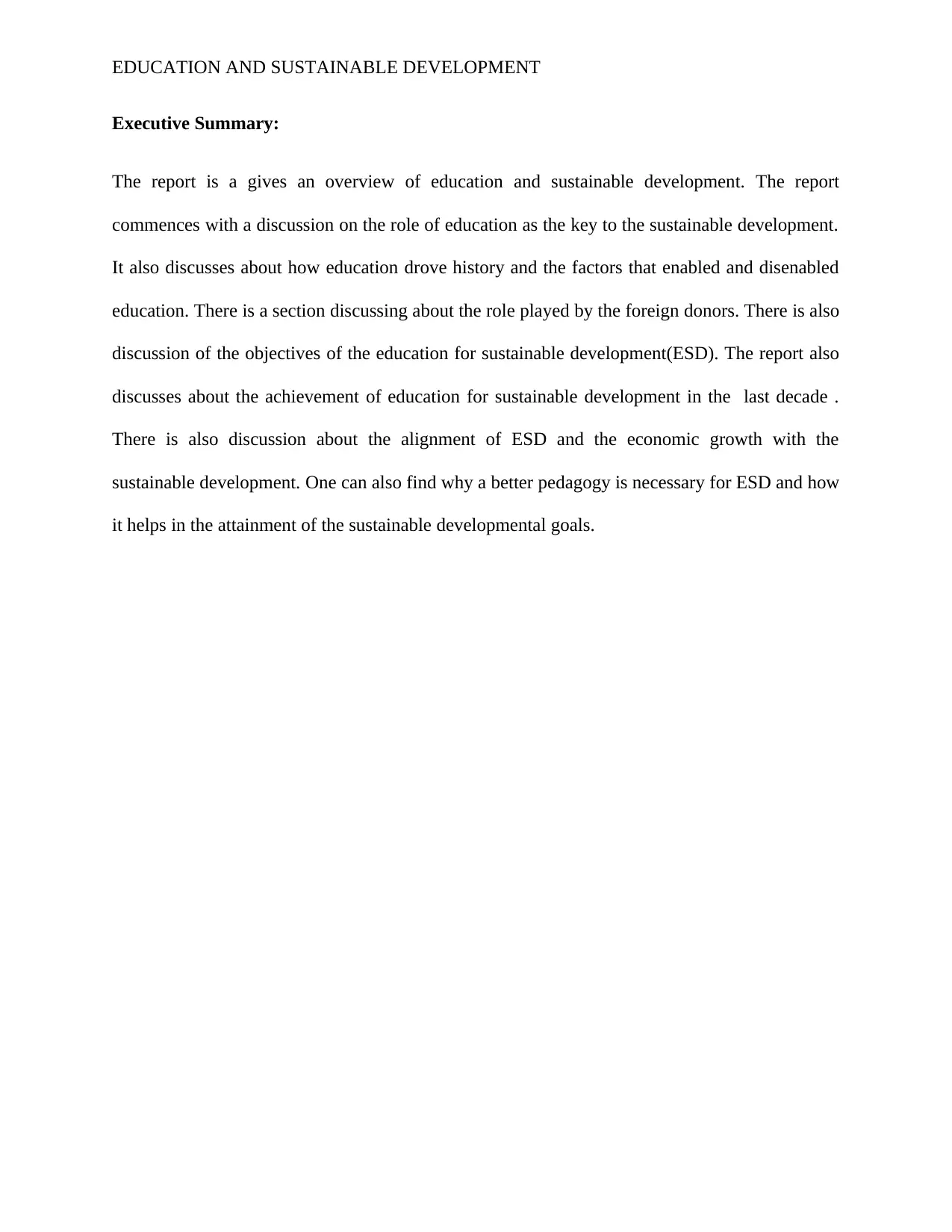
EDUCATION AND SUSTAINABLE DEVELOPMENT
Executive Summary:
The report is a gives an overview of education and sustainable development. The report
commences with a discussion on the role of education as the key to the sustainable development.
It also discusses about how education drove history and the factors that enabled and disenabled
education. There is a section discussing about the role played by the foreign donors. There is also
discussion of the objectives of the education for sustainable development(ESD). The report also
discusses about the achievement of education for sustainable development in the last decade .
There is also discussion about the alignment of ESD and the economic growth with the
sustainable development. One can also find why a better pedagogy is necessary for ESD and how
it helps in the attainment of the sustainable developmental goals.
Executive Summary:
The report is a gives an overview of education and sustainable development. The report
commences with a discussion on the role of education as the key to the sustainable development.
It also discusses about how education drove history and the factors that enabled and disenabled
education. There is a section discussing about the role played by the foreign donors. There is also
discussion of the objectives of the education for sustainable development(ESD). The report also
discusses about the achievement of education for sustainable development in the last decade .
There is also discussion about the alignment of ESD and the economic growth with the
sustainable development. One can also find why a better pedagogy is necessary for ESD and how
it helps in the attainment of the sustainable developmental goals.
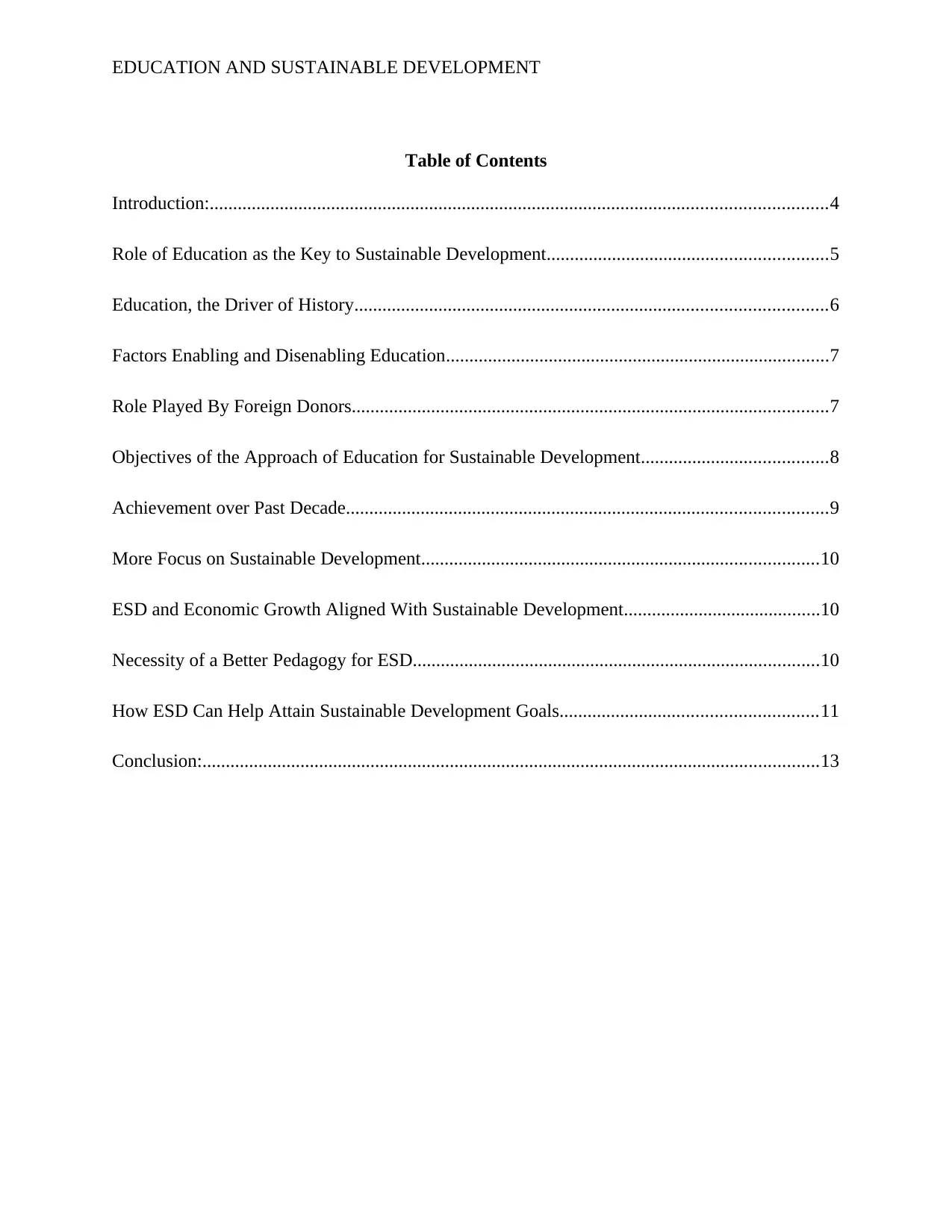
EDUCATION AND SUSTAINABLE DEVELOPMENT
Table of Contents
Introduction:....................................................................................................................................4
Role of Education as the Key to Sustainable Development............................................................5
Education, the Driver of History.....................................................................................................6
Factors Enabling and Disenabling Education..................................................................................7
Role Played By Foreign Donors......................................................................................................7
Objectives of the Approach of Education for Sustainable Development........................................8
Achievement over Past Decade.......................................................................................................9
More Focus on Sustainable Development.....................................................................................10
ESD and Economic Growth Aligned With Sustainable Development..........................................10
Necessity of a Better Pedagogy for ESD.......................................................................................10
How ESD Can Help Attain Sustainable Development Goals.......................................................11
Conclusion:....................................................................................................................................13
Table of Contents
Introduction:....................................................................................................................................4
Role of Education as the Key to Sustainable Development............................................................5
Education, the Driver of History.....................................................................................................6
Factors Enabling and Disenabling Education..................................................................................7
Role Played By Foreign Donors......................................................................................................7
Objectives of the Approach of Education for Sustainable Development........................................8
Achievement over Past Decade.......................................................................................................9
More Focus on Sustainable Development.....................................................................................10
ESD and Economic Growth Aligned With Sustainable Development..........................................10
Necessity of a Better Pedagogy for ESD.......................................................................................10
How ESD Can Help Attain Sustainable Development Goals.......................................................11
Conclusion:....................................................................................................................................13
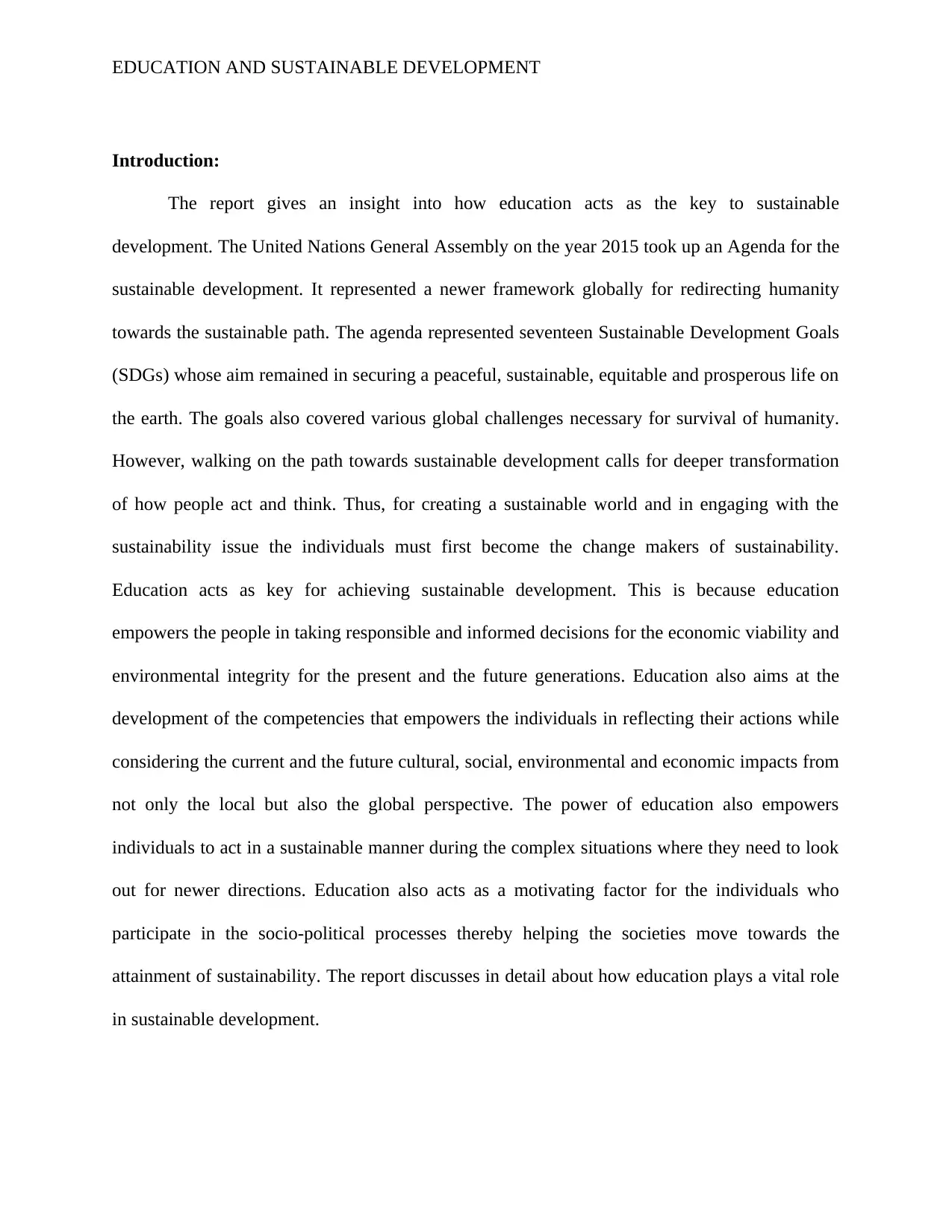
EDUCATION AND SUSTAINABLE DEVELOPMENT
Introduction:
The report gives an insight into how education acts as the key to sustainable
development. The United Nations General Assembly on the year 2015 took up an Agenda for the
sustainable development. It represented a newer framework globally for redirecting humanity
towards the sustainable path. The agenda represented seventeen Sustainable Development Goals
(SDGs) whose aim remained in securing a peaceful, sustainable, equitable and prosperous life on
the earth. The goals also covered various global challenges necessary for survival of humanity.
However, walking on the path towards sustainable development calls for deeper transformation
of how people act and think. Thus, for creating a sustainable world and in engaging with the
sustainability issue the individuals must first become the change makers of sustainability.
Education acts as key for achieving sustainable development. This is because education
empowers the people in taking responsible and informed decisions for the economic viability and
environmental integrity for the present and the future generations. Education also aims at the
development of the competencies that empowers the individuals in reflecting their actions while
considering the current and the future cultural, social, environmental and economic impacts from
not only the local but also the global perspective. The power of education also empowers
individuals to act in a sustainable manner during the complex situations where they need to look
out for newer directions. Education also acts as a motivating factor for the individuals who
participate in the socio-political processes thereby helping the societies move towards the
attainment of sustainability. The report discusses in detail about how education plays a vital role
in sustainable development.
Introduction:
The report gives an insight into how education acts as the key to sustainable
development. The United Nations General Assembly on the year 2015 took up an Agenda for the
sustainable development. It represented a newer framework globally for redirecting humanity
towards the sustainable path. The agenda represented seventeen Sustainable Development Goals
(SDGs) whose aim remained in securing a peaceful, sustainable, equitable and prosperous life on
the earth. The goals also covered various global challenges necessary for survival of humanity.
However, walking on the path towards sustainable development calls for deeper transformation
of how people act and think. Thus, for creating a sustainable world and in engaging with the
sustainability issue the individuals must first become the change makers of sustainability.
Education acts as key for achieving sustainable development. This is because education
empowers the people in taking responsible and informed decisions for the economic viability and
environmental integrity for the present and the future generations. Education also aims at the
development of the competencies that empowers the individuals in reflecting their actions while
considering the current and the future cultural, social, environmental and economic impacts from
not only the local but also the global perspective. The power of education also empowers
individuals to act in a sustainable manner during the complex situations where they need to look
out for newer directions. Education also acts as a motivating factor for the individuals who
participate in the socio-political processes thereby helping the societies move towards the
attainment of sustainability. The report discusses in detail about how education plays a vital role
in sustainable development.
Secure Best Marks with AI Grader
Need help grading? Try our AI Grader for instant feedback on your assignments.
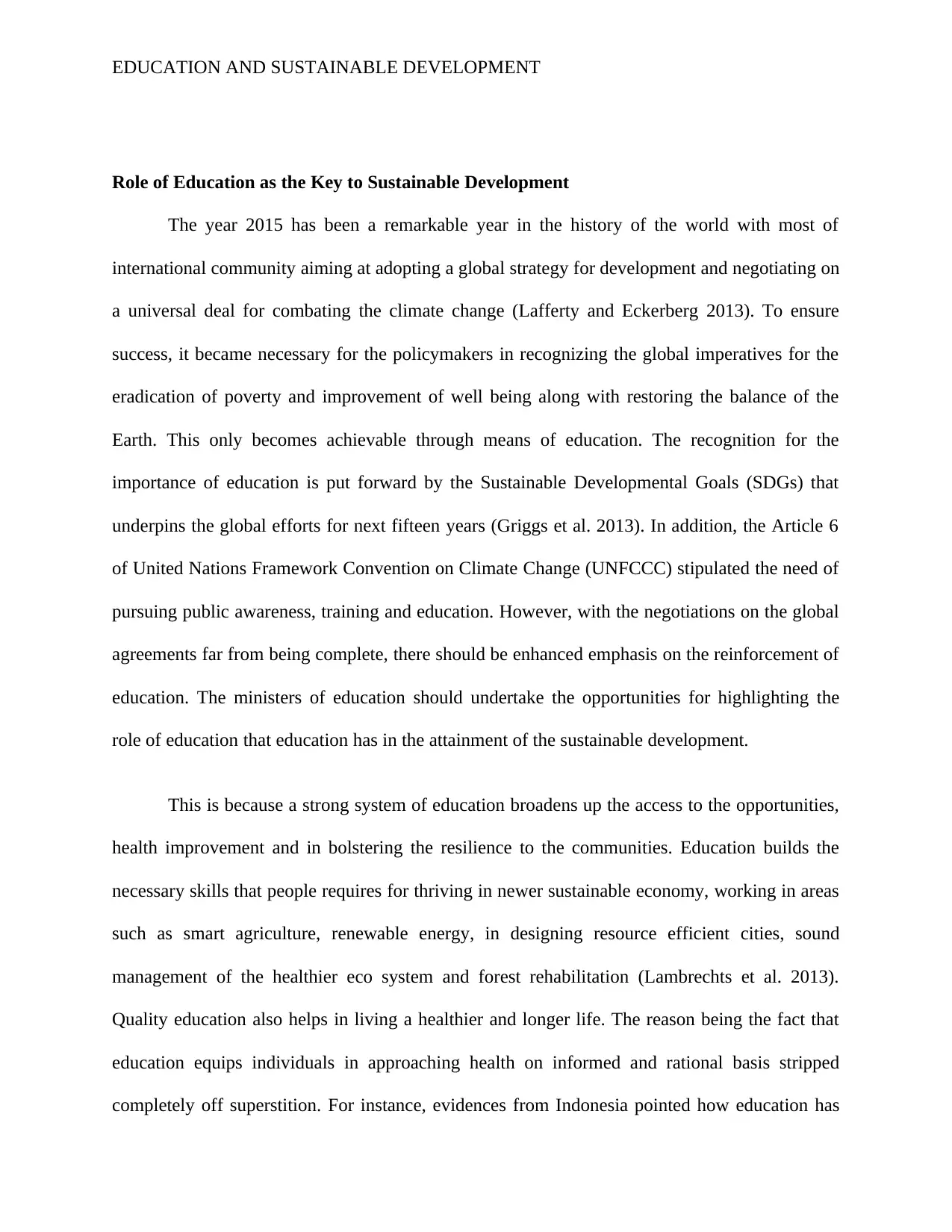
EDUCATION AND SUSTAINABLE DEVELOPMENT
Role of Education as the Key to Sustainable Development
The year 2015 has been a remarkable year in the history of the world with most of
international community aiming at adopting a global strategy for development and negotiating on
a universal deal for combating the climate change (Lafferty and Eckerberg 2013). To ensure
success, it became necessary for the policymakers in recognizing the global imperatives for the
eradication of poverty and improvement of well being along with restoring the balance of the
Earth. This only becomes achievable through means of education. The recognition for the
importance of education is put forward by the Sustainable Developmental Goals (SDGs) that
underpins the global efforts for next fifteen years (Griggs et al. 2013). In addition, the Article 6
of United Nations Framework Convention on Climate Change (UNFCCC) stipulated the need of
pursuing public awareness, training and education. However, with the negotiations on the global
agreements far from being complete, there should be enhanced emphasis on the reinforcement of
education. The ministers of education should undertake the opportunities for highlighting the
role of education that education has in the attainment of the sustainable development.
This is because a strong system of education broadens up the access to the opportunities,
health improvement and in bolstering the resilience to the communities. Education builds the
necessary skills that people requires for thriving in newer sustainable economy, working in areas
such as smart agriculture, renewable energy, in designing resource efficient cities, sound
management of the healthier eco system and forest rehabilitation (Lambrechts et al. 2013).
Quality education also helps in living a healthier and longer life. The reason being the fact that
education equips individuals in approaching health on informed and rational basis stripped
completely off superstition. For instance, evidences from Indonesia pointed how education has
Role of Education as the Key to Sustainable Development
The year 2015 has been a remarkable year in the history of the world with most of
international community aiming at adopting a global strategy for development and negotiating on
a universal deal for combating the climate change (Lafferty and Eckerberg 2013). To ensure
success, it became necessary for the policymakers in recognizing the global imperatives for the
eradication of poverty and improvement of well being along with restoring the balance of the
Earth. This only becomes achievable through means of education. The recognition for the
importance of education is put forward by the Sustainable Developmental Goals (SDGs) that
underpins the global efforts for next fifteen years (Griggs et al. 2013). In addition, the Article 6
of United Nations Framework Convention on Climate Change (UNFCCC) stipulated the need of
pursuing public awareness, training and education. However, with the negotiations on the global
agreements far from being complete, there should be enhanced emphasis on the reinforcement of
education. The ministers of education should undertake the opportunities for highlighting the
role of education that education has in the attainment of the sustainable development.
This is because a strong system of education broadens up the access to the opportunities,
health improvement and in bolstering the resilience to the communities. Education builds the
necessary skills that people requires for thriving in newer sustainable economy, working in areas
such as smart agriculture, renewable energy, in designing resource efficient cities, sound
management of the healthier eco system and forest rehabilitation (Lambrechts et al. 2013).
Quality education also helps in living a healthier and longer life. The reason being the fact that
education equips individuals in approaching health on informed and rational basis stripped
completely off superstition. For instance, evidences from Indonesia pointed how education has
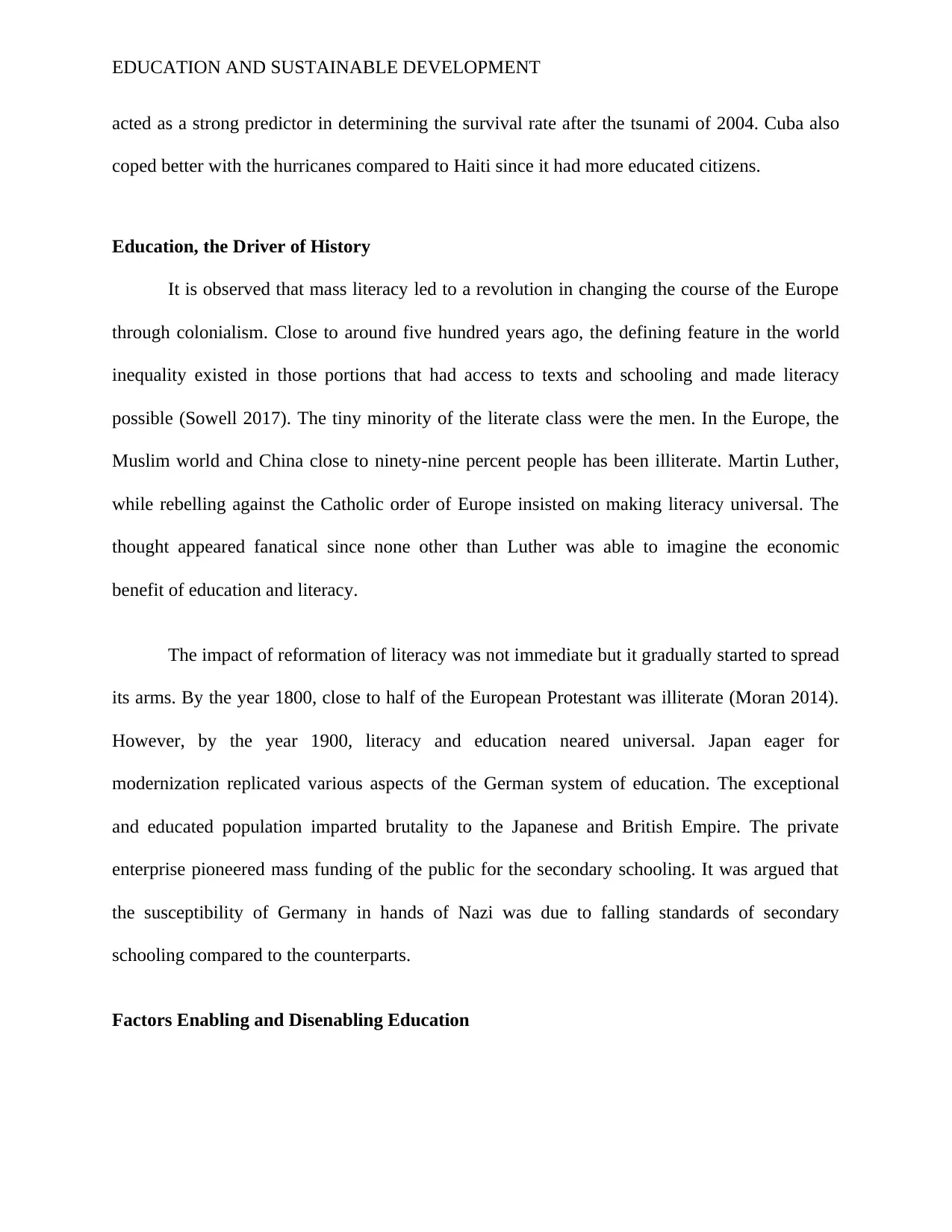
EDUCATION AND SUSTAINABLE DEVELOPMENT
acted as a strong predictor in determining the survival rate after the tsunami of 2004. Cuba also
coped better with the hurricanes compared to Haiti since it had more educated citizens.
Education, the Driver of History
It is observed that mass literacy led to a revolution in changing the course of the Europe
through colonialism. Close to around five hundred years ago, the defining feature in the world
inequality existed in those portions that had access to texts and schooling and made literacy
possible (Sowell 2017). The tiny minority of the literate class were the men. In the Europe, the
Muslim world and China close to ninety-nine percent people has been illiterate. Martin Luther,
while rebelling against the Catholic order of Europe insisted on making literacy universal. The
thought appeared fanatical since none other than Luther was able to imagine the economic
benefit of education and literacy.
The impact of reformation of literacy was not immediate but it gradually started to spread
its arms. By the year 1800, close to half of the European Protestant was illiterate (Moran 2014).
However, by the year 1900, literacy and education neared universal. Japan eager for
modernization replicated various aspects of the German system of education. The exceptional
and educated population imparted brutality to the Japanese and British Empire. The private
enterprise pioneered mass funding of the public for the secondary schooling. It was argued that
the susceptibility of Germany in hands of Nazi was due to falling standards of secondary
schooling compared to the counterparts.
Factors Enabling and Disenabling Education
acted as a strong predictor in determining the survival rate after the tsunami of 2004. Cuba also
coped better with the hurricanes compared to Haiti since it had more educated citizens.
Education, the Driver of History
It is observed that mass literacy led to a revolution in changing the course of the Europe
through colonialism. Close to around five hundred years ago, the defining feature in the world
inequality existed in those portions that had access to texts and schooling and made literacy
possible (Sowell 2017). The tiny minority of the literate class were the men. In the Europe, the
Muslim world and China close to ninety-nine percent people has been illiterate. Martin Luther,
while rebelling against the Catholic order of Europe insisted on making literacy universal. The
thought appeared fanatical since none other than Luther was able to imagine the economic
benefit of education and literacy.
The impact of reformation of literacy was not immediate but it gradually started to spread
its arms. By the year 1800, close to half of the European Protestant was illiterate (Moran 2014).
However, by the year 1900, literacy and education neared universal. Japan eager for
modernization replicated various aspects of the German system of education. The exceptional
and educated population imparted brutality to the Japanese and British Empire. The private
enterprise pioneered mass funding of the public for the secondary schooling. It was argued that
the susceptibility of Germany in hands of Nazi was due to falling standards of secondary
schooling compared to the counterparts.
Factors Enabling and Disenabling Education
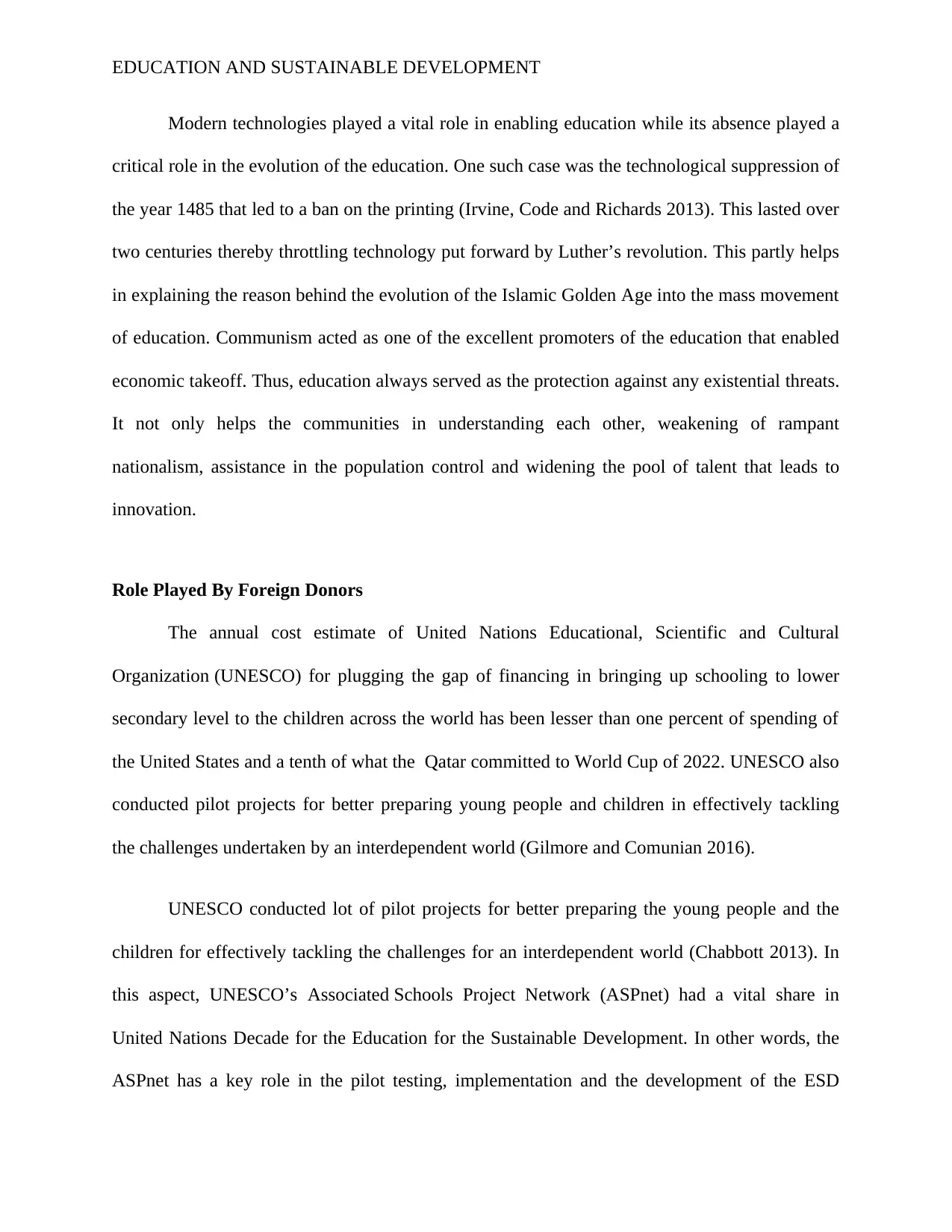
EDUCATION AND SUSTAINABLE DEVELOPMENT
Modern technologies played a vital role in enabling education while its absence played a
critical role in the evolution of the education. One such case was the technological suppression of
the year 1485 that led to a ban on the printing (Irvine, Code and Richards 2013). This lasted over
two centuries thereby throttling technology put forward by Luther’s revolution. This partly helps
in explaining the reason behind the evolution of the Islamic Golden Age into the mass movement
of education. Communism acted as one of the excellent promoters of the education that enabled
economic takeoff. Thus, education always served as the protection against any existential threats.
It not only helps the communities in understanding each other, weakening of rampant
nationalism, assistance in the population control and widening the pool of talent that leads to
innovation.
Role Played By Foreign Donors
The annual cost estimate of United Nations Educational, Scientific and Cultural
Organization (UNESCO) for plugging the gap of financing in bringing up schooling to lower
secondary level to the children across the world has been lesser than one percent of spending of
the United States and a tenth of what the Qatar committed to World Cup of 2022. UNESCO also
conducted pilot projects for better preparing young people and children in effectively tackling
the challenges undertaken by an interdependent world (Gilmore and Comunian 2016).
UNESCO conducted lot of pilot projects for better preparing the young people and the
children for effectively tackling the challenges for an interdependent world (Chabbott 2013). In
this aspect, UNESCO’s Associated Schools Project Network (ASPnet) had a vital share in
United Nations Decade for the Education for the Sustainable Development. In other words, the
ASPnet has a key role in the pilot testing, implementation and the development of the ESD
Modern technologies played a vital role in enabling education while its absence played a
critical role in the evolution of the education. One such case was the technological suppression of
the year 1485 that led to a ban on the printing (Irvine, Code and Richards 2013). This lasted over
two centuries thereby throttling technology put forward by Luther’s revolution. This partly helps
in explaining the reason behind the evolution of the Islamic Golden Age into the mass movement
of education. Communism acted as one of the excellent promoters of the education that enabled
economic takeoff. Thus, education always served as the protection against any existential threats.
It not only helps the communities in understanding each other, weakening of rampant
nationalism, assistance in the population control and widening the pool of talent that leads to
innovation.
Role Played By Foreign Donors
The annual cost estimate of United Nations Educational, Scientific and Cultural
Organization (UNESCO) for plugging the gap of financing in bringing up schooling to lower
secondary level to the children across the world has been lesser than one percent of spending of
the United States and a tenth of what the Qatar committed to World Cup of 2022. UNESCO also
conducted pilot projects for better preparing young people and children in effectively tackling
the challenges undertaken by an interdependent world (Gilmore and Comunian 2016).
UNESCO conducted lot of pilot projects for better preparing the young people and the
children for effectively tackling the challenges for an interdependent world (Chabbott 2013). In
this aspect, UNESCO’s Associated Schools Project Network (ASPnet) had a vital share in
United Nations Decade for the Education for the Sustainable Development. In other words, the
ASPnet has a key role in the pilot testing, implementation and the development of the ESD
Paraphrase This Document
Need a fresh take? Get an instant paraphrase of this document with our AI Paraphraser
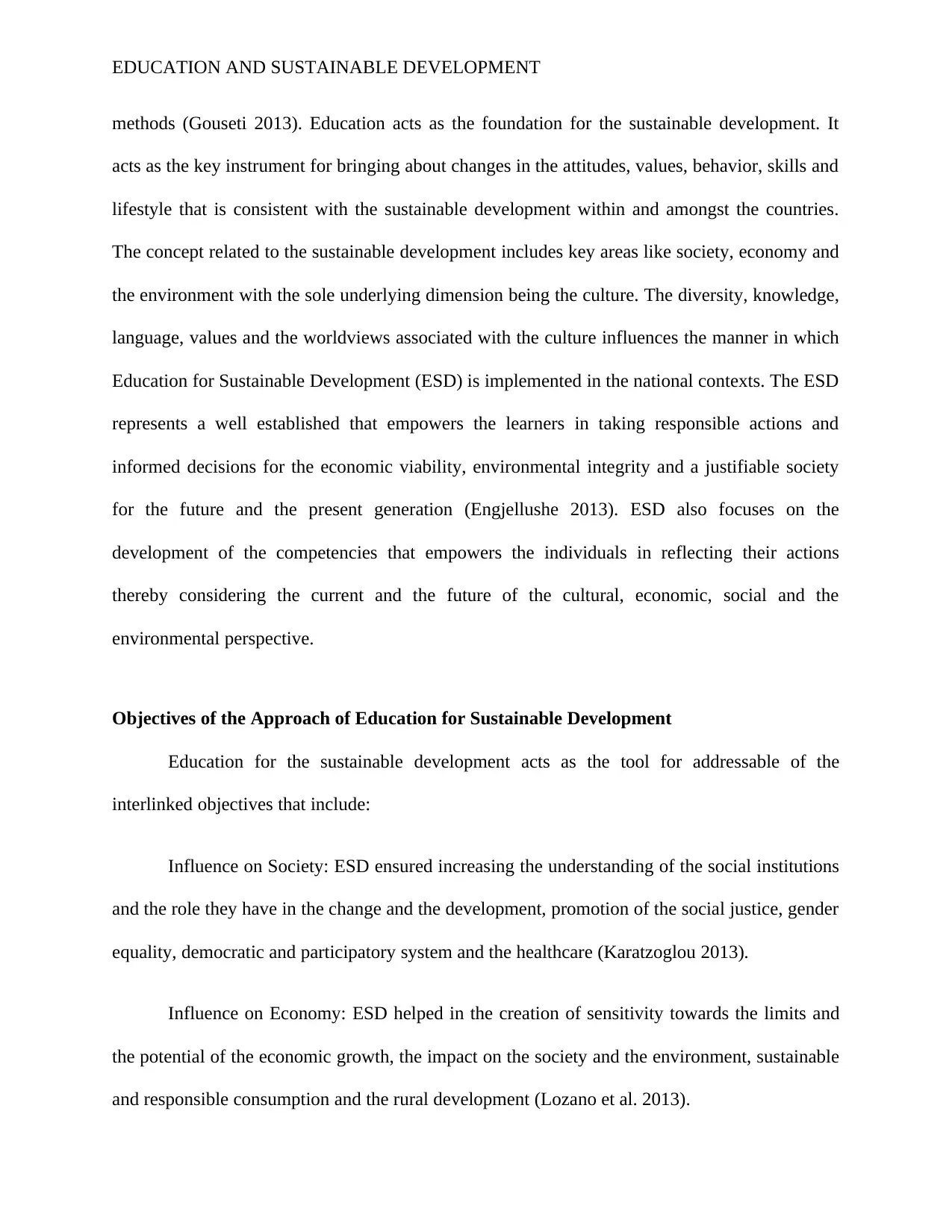
EDUCATION AND SUSTAINABLE DEVELOPMENT
methods (Gouseti 2013). Education acts as the foundation for the sustainable development. It
acts as the key instrument for bringing about changes in the attitudes, values, behavior, skills and
lifestyle that is consistent with the sustainable development within and amongst the countries.
The concept related to the sustainable development includes key areas like society, economy and
the environment with the sole underlying dimension being the culture. The diversity, knowledge,
language, values and the worldviews associated with the culture influences the manner in which
Education for Sustainable Development (ESD) is implemented in the national contexts. The ESD
represents a well established that empowers the learners in taking responsible actions and
informed decisions for the economic viability, environmental integrity and a justifiable society
for the future and the present generation (Engjellushe 2013). ESD also focuses on the
development of the competencies that empowers the individuals in reflecting their actions
thereby considering the current and the future of the cultural, economic, social and the
environmental perspective.
Objectives of the Approach of Education for Sustainable Development
Education for the sustainable development acts as the tool for addressable of the
interlinked objectives that include:
Influence on Society: ESD ensured increasing the understanding of the social institutions
and the role they have in the change and the development, promotion of the social justice, gender
equality, democratic and participatory system and the healthcare (Karatzoglou 2013).
Influence on Economy: ESD helped in the creation of sensitivity towards the limits and
the potential of the economic growth, the impact on the society and the environment, sustainable
and responsible consumption and the rural development (Lozano et al. 2013).
methods (Gouseti 2013). Education acts as the foundation for the sustainable development. It
acts as the key instrument for bringing about changes in the attitudes, values, behavior, skills and
lifestyle that is consistent with the sustainable development within and amongst the countries.
The concept related to the sustainable development includes key areas like society, economy and
the environment with the sole underlying dimension being the culture. The diversity, knowledge,
language, values and the worldviews associated with the culture influences the manner in which
Education for Sustainable Development (ESD) is implemented in the national contexts. The ESD
represents a well established that empowers the learners in taking responsible actions and
informed decisions for the economic viability, environmental integrity and a justifiable society
for the future and the present generation (Engjellushe 2013). ESD also focuses on the
development of the competencies that empowers the individuals in reflecting their actions
thereby considering the current and the future of the cultural, economic, social and the
environmental perspective.
Objectives of the Approach of Education for Sustainable Development
Education for the sustainable development acts as the tool for addressable of the
interlinked objectives that include:
Influence on Society: ESD ensured increasing the understanding of the social institutions
and the role they have in the change and the development, promotion of the social justice, gender
equality, democratic and participatory system and the healthcare (Karatzoglou 2013).
Influence on Economy: ESD helped in the creation of sensitivity towards the limits and
the potential of the economic growth, the impact on the society and the environment, sustainable
and responsible consumption and the rural development (Lozano et al. 2013).
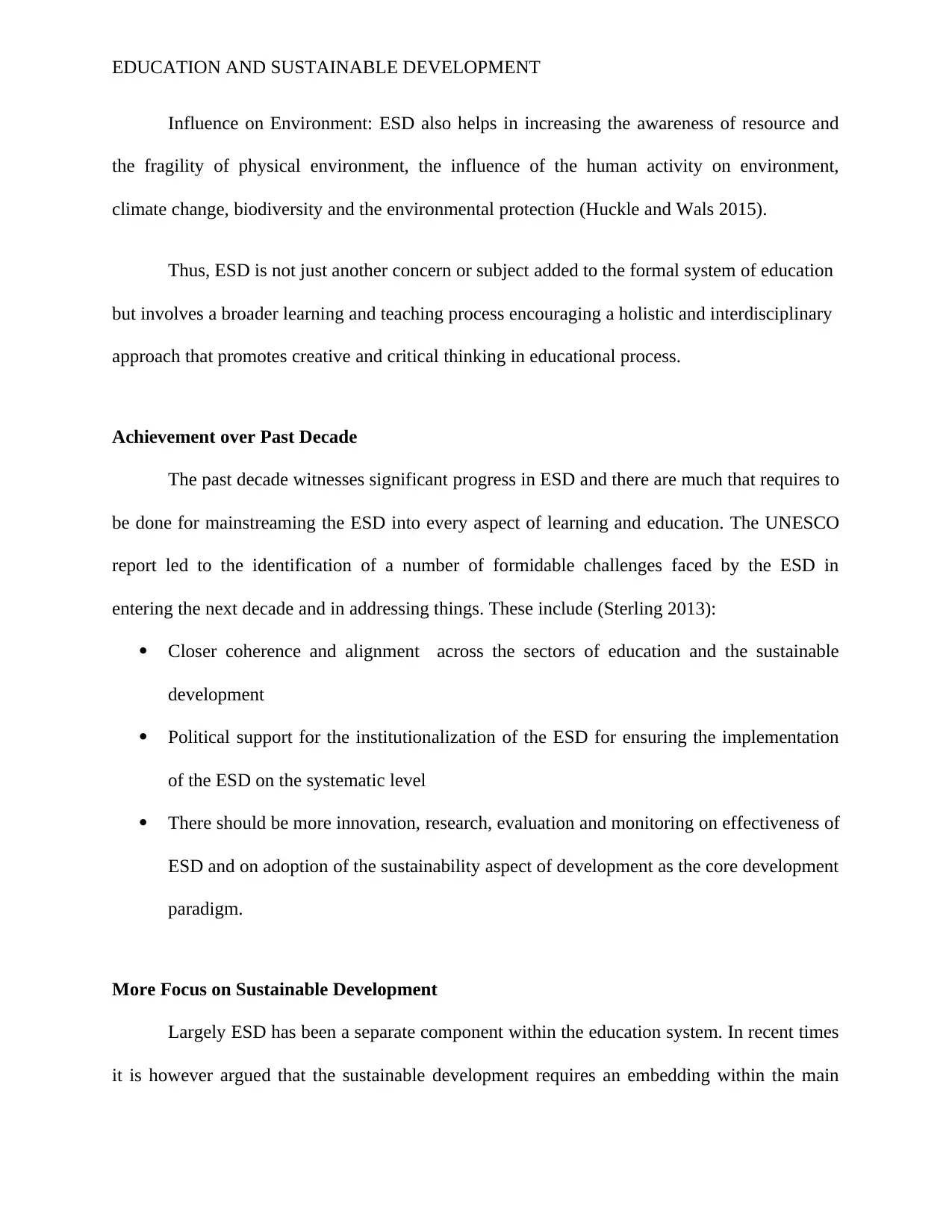
EDUCATION AND SUSTAINABLE DEVELOPMENT
Influence on Environment: ESD also helps in increasing the awareness of resource and
the fragility of physical environment, the influence of the human activity on environment,
climate change, biodiversity and the environmental protection (Huckle and Wals 2015).
Thus, ESD is not just another concern or subject added to the formal system of education
but involves a broader learning and teaching process encouraging a holistic and interdisciplinary
approach that promotes creative and critical thinking in educational process.
Achievement over Past Decade
The past decade witnesses significant progress in ESD and there are much that requires to
be done for mainstreaming the ESD into every aspect of learning and education. The UNESCO
report led to the identification of a number of formidable challenges faced by the ESD in
entering the next decade and in addressing things. These include (Sterling 2013):
Closer coherence and alignment across the sectors of education and the sustainable
development
Political support for the institutionalization of the ESD for ensuring the implementation
of the ESD on the systematic level
There should be more innovation, research, evaluation and monitoring on effectiveness of
ESD and on adoption of the sustainability aspect of development as the core development
paradigm.
More Focus on Sustainable Development
Largely ESD has been a separate component within the education system. In recent times
it is however argued that the sustainable development requires an embedding within the main
Influence on Environment: ESD also helps in increasing the awareness of resource and
the fragility of physical environment, the influence of the human activity on environment,
climate change, biodiversity and the environmental protection (Huckle and Wals 2015).
Thus, ESD is not just another concern or subject added to the formal system of education
but involves a broader learning and teaching process encouraging a holistic and interdisciplinary
approach that promotes creative and critical thinking in educational process.
Achievement over Past Decade
The past decade witnesses significant progress in ESD and there are much that requires to
be done for mainstreaming the ESD into every aspect of learning and education. The UNESCO
report led to the identification of a number of formidable challenges faced by the ESD in
entering the next decade and in addressing things. These include (Sterling 2013):
Closer coherence and alignment across the sectors of education and the sustainable
development
Political support for the institutionalization of the ESD for ensuring the implementation
of the ESD on the systematic level
There should be more innovation, research, evaluation and monitoring on effectiveness of
ESD and on adoption of the sustainability aspect of development as the core development
paradigm.
More Focus on Sustainable Development
Largely ESD has been a separate component within the education system. In recent times
it is however argued that the sustainable development requires an embedding within the main
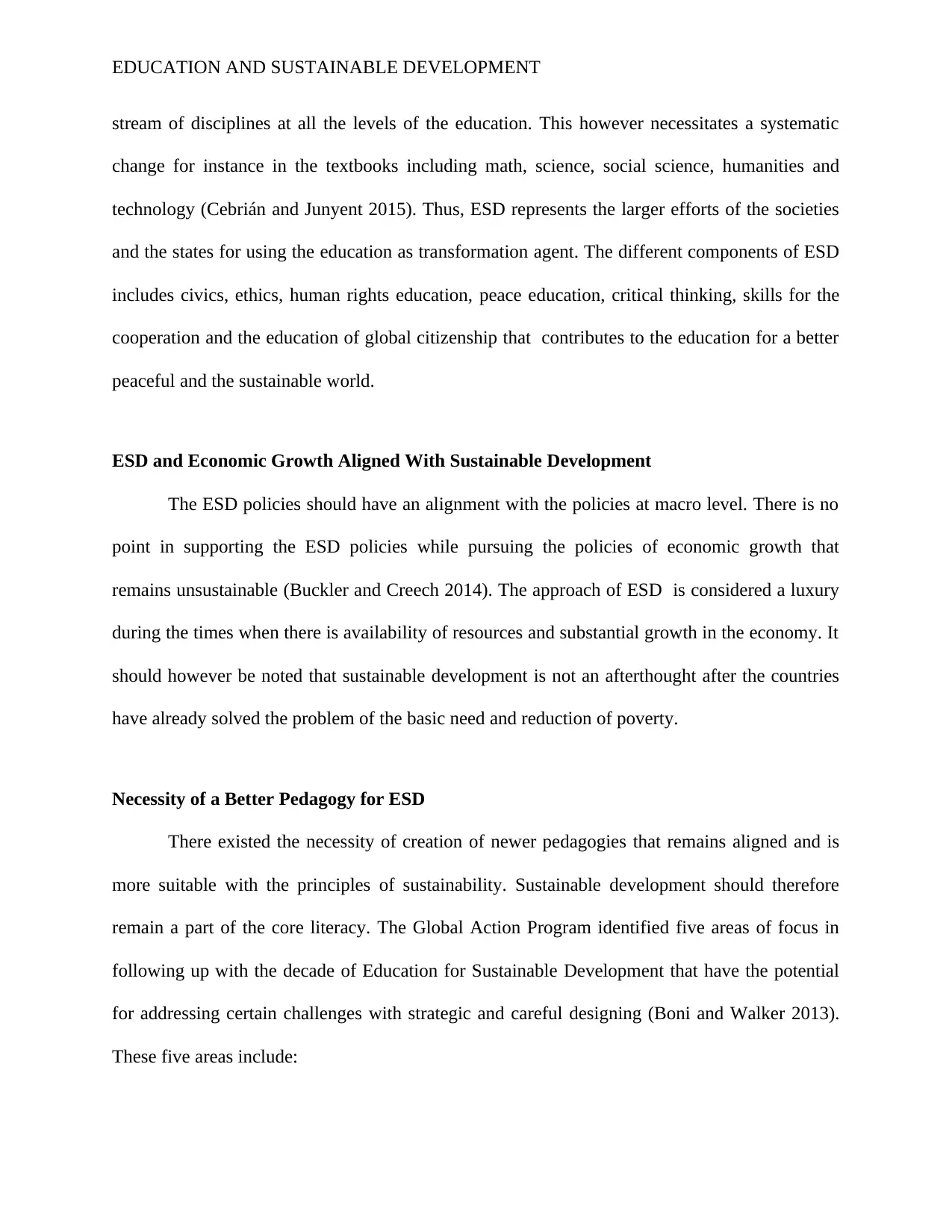
EDUCATION AND SUSTAINABLE DEVELOPMENT
stream of disciplines at all the levels of the education. This however necessitates a systematic
change for instance in the textbooks including math, science, social science, humanities and
technology (Cebrián and Junyent 2015). Thus, ESD represents the larger efforts of the societies
and the states for using the education as transformation agent. The different components of ESD
includes civics, ethics, human rights education, peace education, critical thinking, skills for the
cooperation and the education of global citizenship that contributes to the education for a better
peaceful and the sustainable world.
ESD and Economic Growth Aligned With Sustainable Development
The ESD policies should have an alignment with the policies at macro level. There is no
point in supporting the ESD policies while pursuing the policies of economic growth that
remains unsustainable (Buckler and Creech 2014). The approach of ESD is considered a luxury
during the times when there is availability of resources and substantial growth in the economy. It
should however be noted that sustainable development is not an afterthought after the countries
have already solved the problem of the basic need and reduction of poverty.
Necessity of a Better Pedagogy for ESD
There existed the necessity of creation of newer pedagogies that remains aligned and is
more suitable with the principles of sustainability. Sustainable development should therefore
remain a part of the core literacy. The Global Action Program identified five areas of focus in
following up with the decade of Education for Sustainable Development that have the potential
for addressing certain challenges with strategic and careful designing (Boni and Walker 2013).
These five areas include:
stream of disciplines at all the levels of the education. This however necessitates a systematic
change for instance in the textbooks including math, science, social science, humanities and
technology (Cebrián and Junyent 2015). Thus, ESD represents the larger efforts of the societies
and the states for using the education as transformation agent. The different components of ESD
includes civics, ethics, human rights education, peace education, critical thinking, skills for the
cooperation and the education of global citizenship that contributes to the education for a better
peaceful and the sustainable world.
ESD and Economic Growth Aligned With Sustainable Development
The ESD policies should have an alignment with the policies at macro level. There is no
point in supporting the ESD policies while pursuing the policies of economic growth that
remains unsustainable (Buckler and Creech 2014). The approach of ESD is considered a luxury
during the times when there is availability of resources and substantial growth in the economy. It
should however be noted that sustainable development is not an afterthought after the countries
have already solved the problem of the basic need and reduction of poverty.
Necessity of a Better Pedagogy for ESD
There existed the necessity of creation of newer pedagogies that remains aligned and is
more suitable with the principles of sustainability. Sustainable development should therefore
remain a part of the core literacy. The Global Action Program identified five areas of focus in
following up with the decade of Education for Sustainable Development that have the potential
for addressing certain challenges with strategic and careful designing (Boni and Walker 2013).
These five areas include:
Secure Best Marks with AI Grader
Need help grading? Try our AI Grader for instant feedback on your assignments.
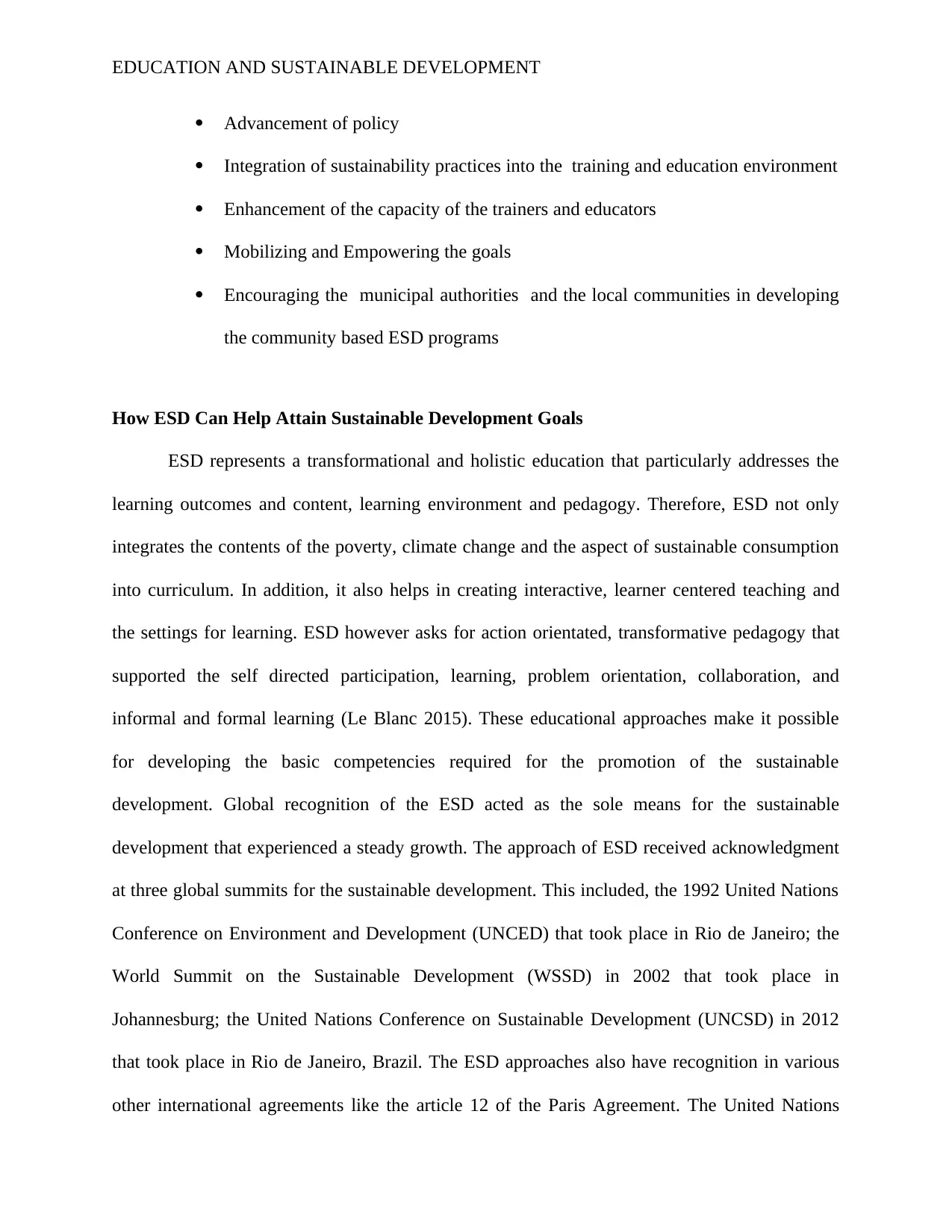
EDUCATION AND SUSTAINABLE DEVELOPMENT
Advancement of policy
Integration of sustainability practices into the training and education environment
Enhancement of the capacity of the trainers and educators
Mobilizing and Empowering the goals
Encouraging the municipal authorities and the local communities in developing
the community based ESD programs
How ESD Can Help Attain Sustainable Development Goals
ESD represents a transformational and holistic education that particularly addresses the
learning outcomes and content, learning environment and pedagogy. Therefore, ESD not only
integrates the contents of the poverty, climate change and the aspect of sustainable consumption
into curriculum. In addition, it also helps in creating interactive, learner centered teaching and
the settings for learning. ESD however asks for action orientated, transformative pedagogy that
supported the self directed participation, learning, problem orientation, collaboration, and
informal and formal learning (Le Blanc 2015). These educational approaches make it possible
for developing the basic competencies required for the promotion of the sustainable
development. Global recognition of the ESD acted as the sole means for the sustainable
development that experienced a steady growth. The approach of ESD received acknowledgment
at three global summits for the sustainable development. This included, the 1992 United Nations
Conference on Environment and Development (UNCED) that took place in Rio de Janeiro; the
World Summit on the Sustainable Development (WSSD) in 2002 that took place in
Johannesburg; the United Nations Conference on Sustainable Development (UNCSD) in 2012
that took place in Rio de Janeiro, Brazil. The ESD approaches also have recognition in various
other international agreements like the article 12 of the Paris Agreement. The United Nations
Advancement of policy
Integration of sustainability practices into the training and education environment
Enhancement of the capacity of the trainers and educators
Mobilizing and Empowering the goals
Encouraging the municipal authorities and the local communities in developing
the community based ESD programs
How ESD Can Help Attain Sustainable Development Goals
ESD represents a transformational and holistic education that particularly addresses the
learning outcomes and content, learning environment and pedagogy. Therefore, ESD not only
integrates the contents of the poverty, climate change and the aspect of sustainable consumption
into curriculum. In addition, it also helps in creating interactive, learner centered teaching and
the settings for learning. ESD however asks for action orientated, transformative pedagogy that
supported the self directed participation, learning, problem orientation, collaboration, and
informal and formal learning (Le Blanc 2015). These educational approaches make it possible
for developing the basic competencies required for the promotion of the sustainable
development. Global recognition of the ESD acted as the sole means for the sustainable
development that experienced a steady growth. The approach of ESD received acknowledgment
at three global summits for the sustainable development. This included, the 1992 United Nations
Conference on Environment and Development (UNCED) that took place in Rio de Janeiro; the
World Summit on the Sustainable Development (WSSD) in 2002 that took place in
Johannesburg; the United Nations Conference on Sustainable Development (UNCSD) in 2012
that took place in Rio de Janeiro, Brazil. The ESD approaches also have recognition in various
other international agreements like the article 12 of the Paris Agreement. The United Nations
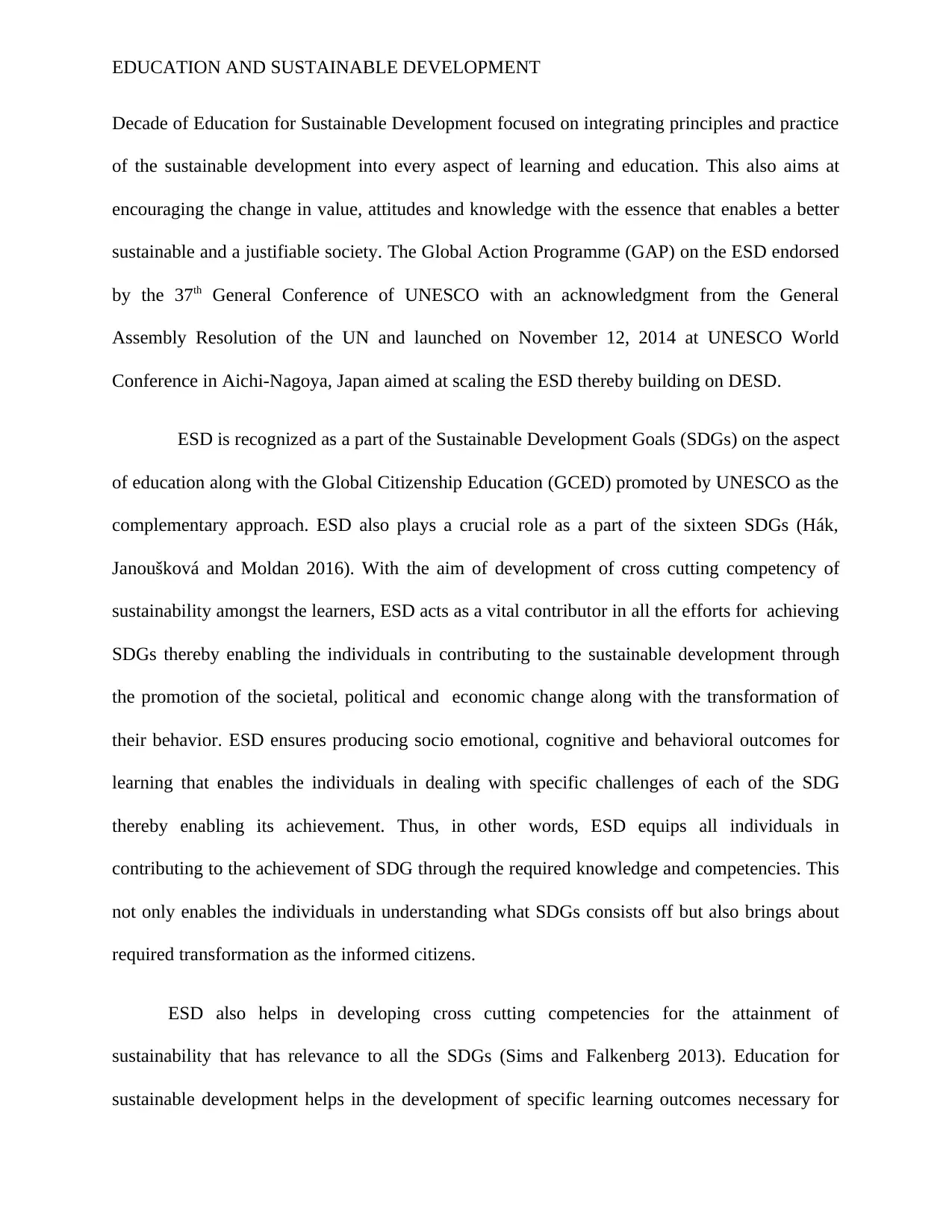
EDUCATION AND SUSTAINABLE DEVELOPMENT
Decade of Education for Sustainable Development focused on integrating principles and practice
of the sustainable development into every aspect of learning and education. This also aims at
encouraging the change in value, attitudes and knowledge with the essence that enables a better
sustainable and a justifiable society. The Global Action Programme (GAP) on the ESD endorsed
by the 37th General Conference of UNESCO with an acknowledgment from the General
Assembly Resolution of the UN and launched on November 12, 2014 at UNESCO World
Conference in Aichi-Nagoya, Japan aimed at scaling the ESD thereby building on DESD.
ESD is recognized as a part of the Sustainable Development Goals (SDGs) on the aspect
of education along with the Global Citizenship Education (GCED) promoted by UNESCO as the
complementary approach. ESD also plays a crucial role as a part of the sixteen SDGs (Hák,
Janoušková and Moldan 2016). With the aim of development of cross cutting competency of
sustainability amongst the learners, ESD acts as a vital contributor in all the efforts for achieving
SDGs thereby enabling the individuals in contributing to the sustainable development through
the promotion of the societal, political and economic change along with the transformation of
their behavior. ESD ensures producing socio emotional, cognitive and behavioral outcomes for
learning that enables the individuals in dealing with specific challenges of each of the SDG
thereby enabling its achievement. Thus, in other words, ESD equips all individuals in
contributing to the achievement of SDG through the required knowledge and competencies. This
not only enables the individuals in understanding what SDGs consists off but also brings about
required transformation as the informed citizens.
ESD also helps in developing cross cutting competencies for the attainment of
sustainability that has relevance to all the SDGs (Sims and Falkenberg 2013). Education for
sustainable development helps in the development of specific learning outcomes necessary for
Decade of Education for Sustainable Development focused on integrating principles and practice
of the sustainable development into every aspect of learning and education. This also aims at
encouraging the change in value, attitudes and knowledge with the essence that enables a better
sustainable and a justifiable society. The Global Action Programme (GAP) on the ESD endorsed
by the 37th General Conference of UNESCO with an acknowledgment from the General
Assembly Resolution of the UN and launched on November 12, 2014 at UNESCO World
Conference in Aichi-Nagoya, Japan aimed at scaling the ESD thereby building on DESD.
ESD is recognized as a part of the Sustainable Development Goals (SDGs) on the aspect
of education along with the Global Citizenship Education (GCED) promoted by UNESCO as the
complementary approach. ESD also plays a crucial role as a part of the sixteen SDGs (Hák,
Janoušková and Moldan 2016). With the aim of development of cross cutting competency of
sustainability amongst the learners, ESD acts as a vital contributor in all the efforts for achieving
SDGs thereby enabling the individuals in contributing to the sustainable development through
the promotion of the societal, political and economic change along with the transformation of
their behavior. ESD ensures producing socio emotional, cognitive and behavioral outcomes for
learning that enables the individuals in dealing with specific challenges of each of the SDG
thereby enabling its achievement. Thus, in other words, ESD equips all individuals in
contributing to the achievement of SDG through the required knowledge and competencies. This
not only enables the individuals in understanding what SDGs consists off but also brings about
required transformation as the informed citizens.
ESD also helps in developing cross cutting competencies for the attainment of
sustainability that has relevance to all the SDGs (Sims and Falkenberg 2013). Education for
sustainable development helps in the development of specific learning outcomes necessary for
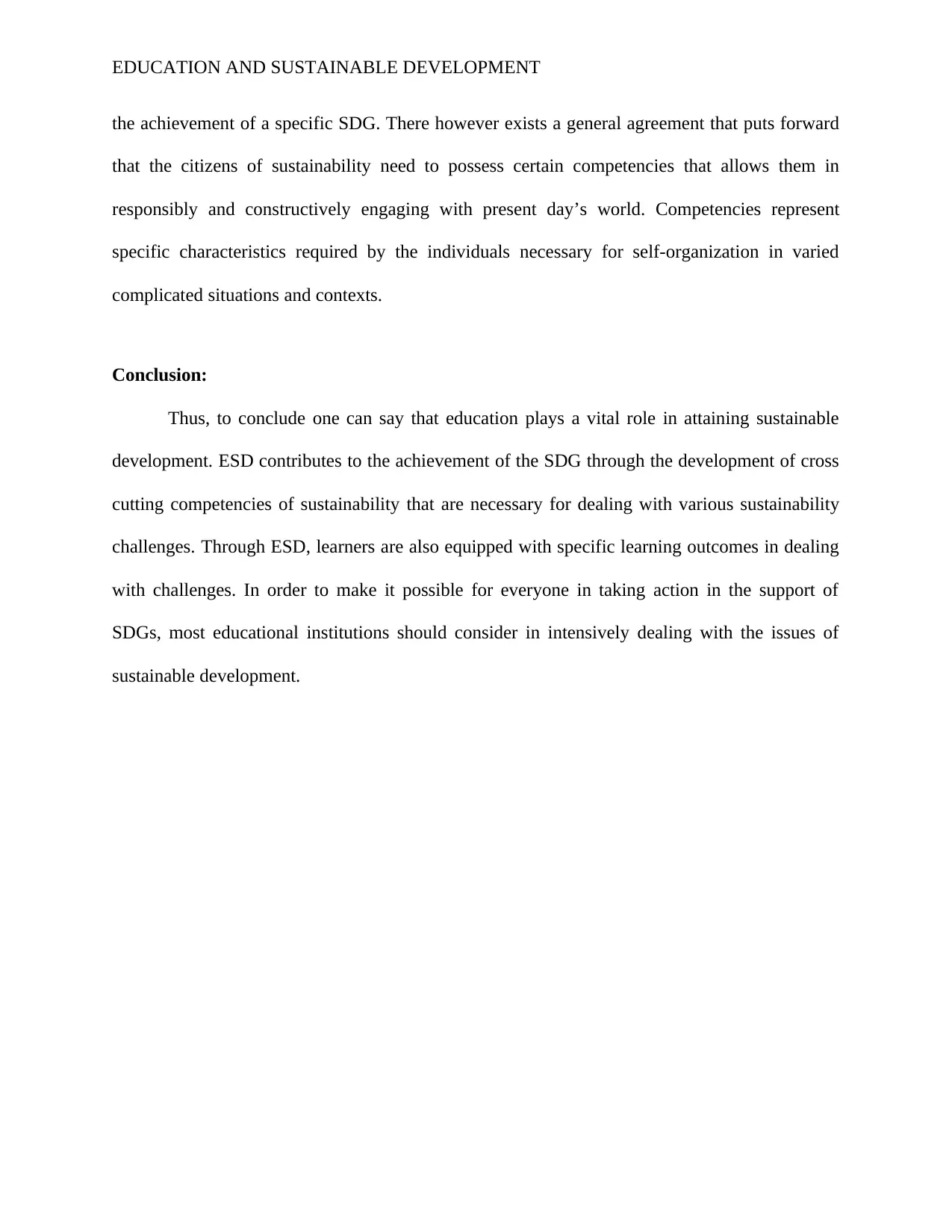
EDUCATION AND SUSTAINABLE DEVELOPMENT
the achievement of a specific SDG. There however exists a general agreement that puts forward
that the citizens of sustainability need to possess certain competencies that allows them in
responsibly and constructively engaging with present day’s world. Competencies represent
specific characteristics required by the individuals necessary for self-organization in varied
complicated situations and contexts.
Conclusion:
Thus, to conclude one can say that education plays a vital role in attaining sustainable
development. ESD contributes to the achievement of the SDG through the development of cross
cutting competencies of sustainability that are necessary for dealing with various sustainability
challenges. Through ESD, learners are also equipped with specific learning outcomes in dealing
with challenges. In order to make it possible for everyone in taking action in the support of
SDGs, most educational institutions should consider in intensively dealing with the issues of
sustainable development.
the achievement of a specific SDG. There however exists a general agreement that puts forward
that the citizens of sustainability need to possess certain competencies that allows them in
responsibly and constructively engaging with present day’s world. Competencies represent
specific characteristics required by the individuals necessary for self-organization in varied
complicated situations and contexts.
Conclusion:
Thus, to conclude one can say that education plays a vital role in attaining sustainable
development. ESD contributes to the achievement of the SDG through the development of cross
cutting competencies of sustainability that are necessary for dealing with various sustainability
challenges. Through ESD, learners are also equipped with specific learning outcomes in dealing
with challenges. In order to make it possible for everyone in taking action in the support of
SDGs, most educational institutions should consider in intensively dealing with the issues of
sustainable development.
Paraphrase This Document
Need a fresh take? Get an instant paraphrase of this document with our AI Paraphraser
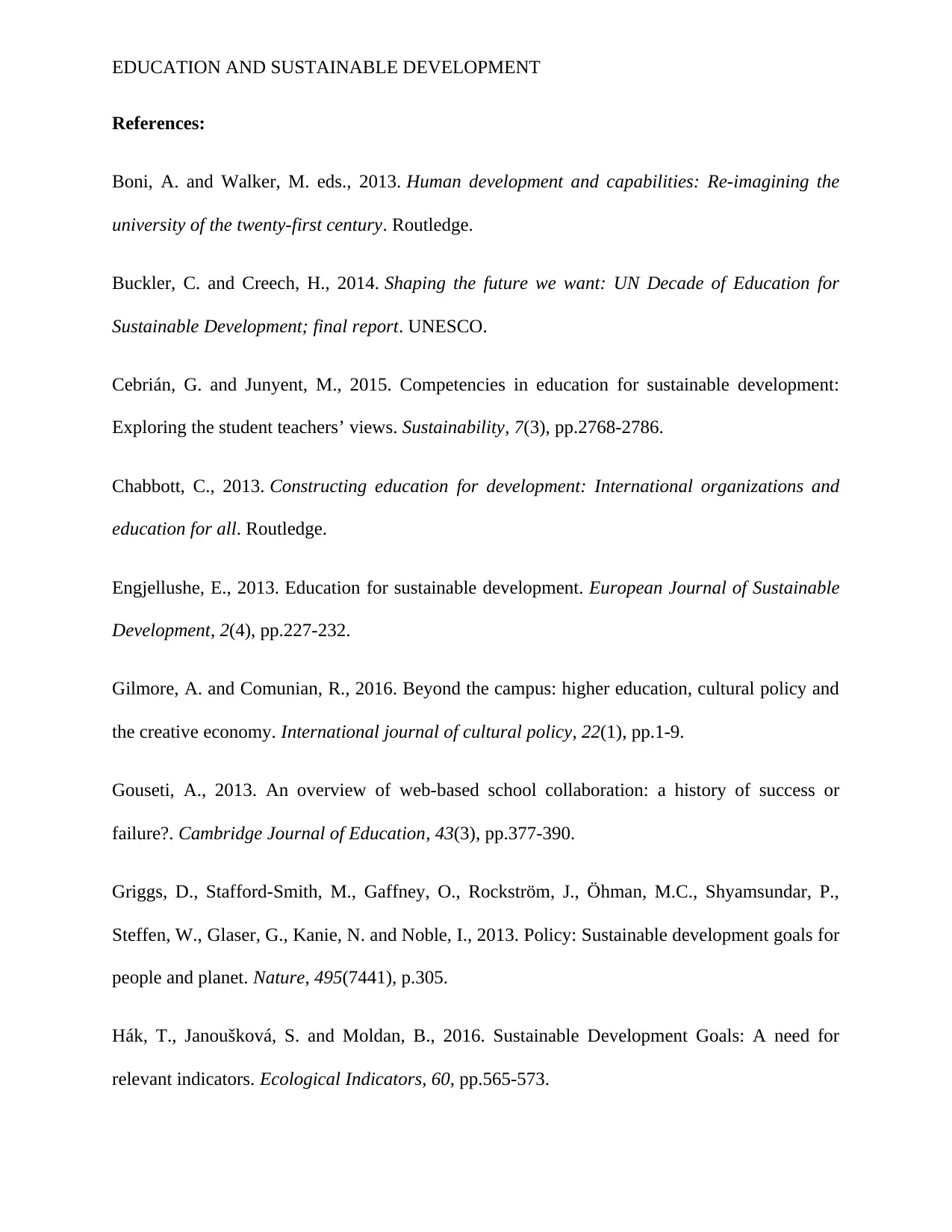
EDUCATION AND SUSTAINABLE DEVELOPMENT
References:
Boni, A. and Walker, M. eds., 2013. Human development and capabilities: Re-imagining the
university of the twenty-first century. Routledge.
Buckler, C. and Creech, H., 2014. Shaping the future we want: UN Decade of Education for
Sustainable Development; final report. UNESCO.
Cebrián, G. and Junyent, M., 2015. Competencies in education for sustainable development:
Exploring the student teachers’ views. Sustainability, 7(3), pp.2768-2786.
Chabbott, C., 2013. Constructing education for development: International organizations and
education for all. Routledge.
Engjellushe, E., 2013. Education for sustainable development. European Journal of Sustainable
Development, 2(4), pp.227-232.
Gilmore, A. and Comunian, R., 2016. Beyond the campus: higher education, cultural policy and
the creative economy. International journal of cultural policy, 22(1), pp.1-9.
Gouseti, A., 2013. An overview of web-based school collaboration: a history of success or
failure?. Cambridge Journal of Education, 43(3), pp.377-390.
Griggs, D., Stafford-Smith, M., Gaffney, O., Rockström, J., Öhman, M.C., Shyamsundar, P.,
Steffen, W., Glaser, G., Kanie, N. and Noble, I., 2013. Policy: Sustainable development goals for
people and planet. Nature, 495(7441), p.305.
Hák, T., Janoušková, S. and Moldan, B., 2016. Sustainable Development Goals: A need for
relevant indicators. Ecological Indicators, 60, pp.565-573.
References:
Boni, A. and Walker, M. eds., 2013. Human development and capabilities: Re-imagining the
university of the twenty-first century. Routledge.
Buckler, C. and Creech, H., 2014. Shaping the future we want: UN Decade of Education for
Sustainable Development; final report. UNESCO.
Cebrián, G. and Junyent, M., 2015. Competencies in education for sustainable development:
Exploring the student teachers’ views. Sustainability, 7(3), pp.2768-2786.
Chabbott, C., 2013. Constructing education for development: International organizations and
education for all. Routledge.
Engjellushe, E., 2013. Education for sustainable development. European Journal of Sustainable
Development, 2(4), pp.227-232.
Gilmore, A. and Comunian, R., 2016. Beyond the campus: higher education, cultural policy and
the creative economy. International journal of cultural policy, 22(1), pp.1-9.
Gouseti, A., 2013. An overview of web-based school collaboration: a history of success or
failure?. Cambridge Journal of Education, 43(3), pp.377-390.
Griggs, D., Stafford-Smith, M., Gaffney, O., Rockström, J., Öhman, M.C., Shyamsundar, P.,
Steffen, W., Glaser, G., Kanie, N. and Noble, I., 2013. Policy: Sustainable development goals for
people and planet. Nature, 495(7441), p.305.
Hák, T., Janoušková, S. and Moldan, B., 2016. Sustainable Development Goals: A need for
relevant indicators. Ecological Indicators, 60, pp.565-573.
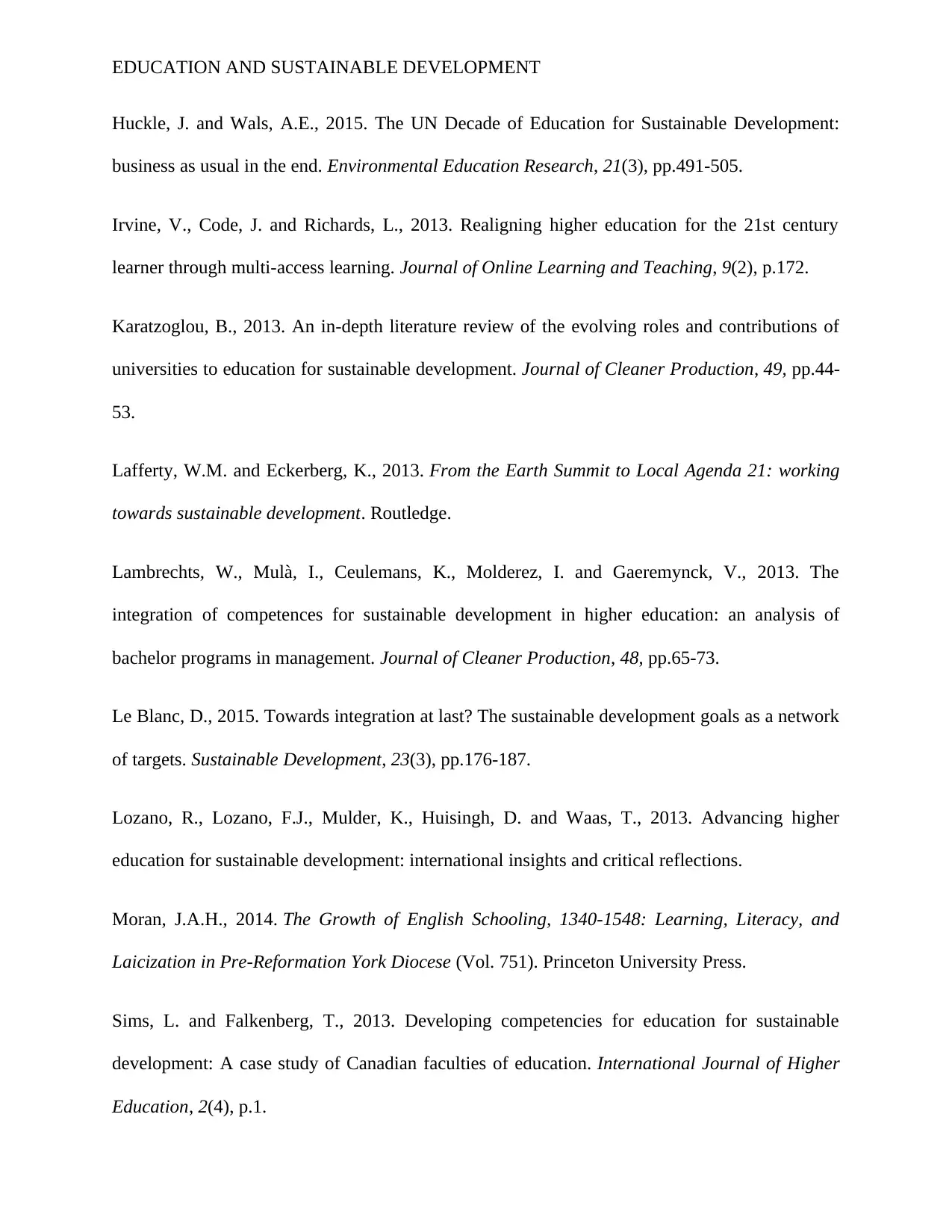
EDUCATION AND SUSTAINABLE DEVELOPMENT
Huckle, J. and Wals, A.E., 2015. The UN Decade of Education for Sustainable Development:
business as usual in the end. Environmental Education Research, 21(3), pp.491-505.
Irvine, V., Code, J. and Richards, L., 2013. Realigning higher education for the 21st century
learner through multi-access learning. Journal of Online Learning and Teaching, 9(2), p.172.
Karatzoglou, B., 2013. An in-depth literature review of the evolving roles and contributions of
universities to education for sustainable development. Journal of Cleaner Production, 49, pp.44-
53.
Lafferty, W.M. and Eckerberg, K., 2013. From the Earth Summit to Local Agenda 21: working
towards sustainable development. Routledge.
Lambrechts, W., Mulà, I., Ceulemans, K., Molderez, I. and Gaeremynck, V., 2013. The
integration of competences for sustainable development in higher education: an analysis of
bachelor programs in management. Journal of Cleaner Production, 48, pp.65-73.
Le Blanc, D., 2015. Towards integration at last? The sustainable development goals as a network
of targets. Sustainable Development, 23(3), pp.176-187.
Lozano, R., Lozano, F.J., Mulder, K., Huisingh, D. and Waas, T., 2013. Advancing higher
education for sustainable development: international insights and critical reflections.
Moran, J.A.H., 2014. The Growth of English Schooling, 1340-1548: Learning, Literacy, and
Laicization in Pre-Reformation York Diocese (Vol. 751). Princeton University Press.
Sims, L. and Falkenberg, T., 2013. Developing competencies for education for sustainable
development: A case study of Canadian faculties of education. International Journal of Higher
Education, 2(4), p.1.
Huckle, J. and Wals, A.E., 2015. The UN Decade of Education for Sustainable Development:
business as usual in the end. Environmental Education Research, 21(3), pp.491-505.
Irvine, V., Code, J. and Richards, L., 2013. Realigning higher education for the 21st century
learner through multi-access learning. Journal of Online Learning and Teaching, 9(2), p.172.
Karatzoglou, B., 2013. An in-depth literature review of the evolving roles and contributions of
universities to education for sustainable development. Journal of Cleaner Production, 49, pp.44-
53.
Lafferty, W.M. and Eckerberg, K., 2013. From the Earth Summit to Local Agenda 21: working
towards sustainable development. Routledge.
Lambrechts, W., Mulà, I., Ceulemans, K., Molderez, I. and Gaeremynck, V., 2013. The
integration of competences for sustainable development in higher education: an analysis of
bachelor programs in management. Journal of Cleaner Production, 48, pp.65-73.
Le Blanc, D., 2015. Towards integration at last? The sustainable development goals as a network
of targets. Sustainable Development, 23(3), pp.176-187.
Lozano, R., Lozano, F.J., Mulder, K., Huisingh, D. and Waas, T., 2013. Advancing higher
education for sustainable development: international insights and critical reflections.
Moran, J.A.H., 2014. The Growth of English Schooling, 1340-1548: Learning, Literacy, and
Laicization in Pre-Reformation York Diocese (Vol. 751). Princeton University Press.
Sims, L. and Falkenberg, T., 2013. Developing competencies for education for sustainable
development: A case study of Canadian faculties of education. International Journal of Higher
Education, 2(4), p.1.
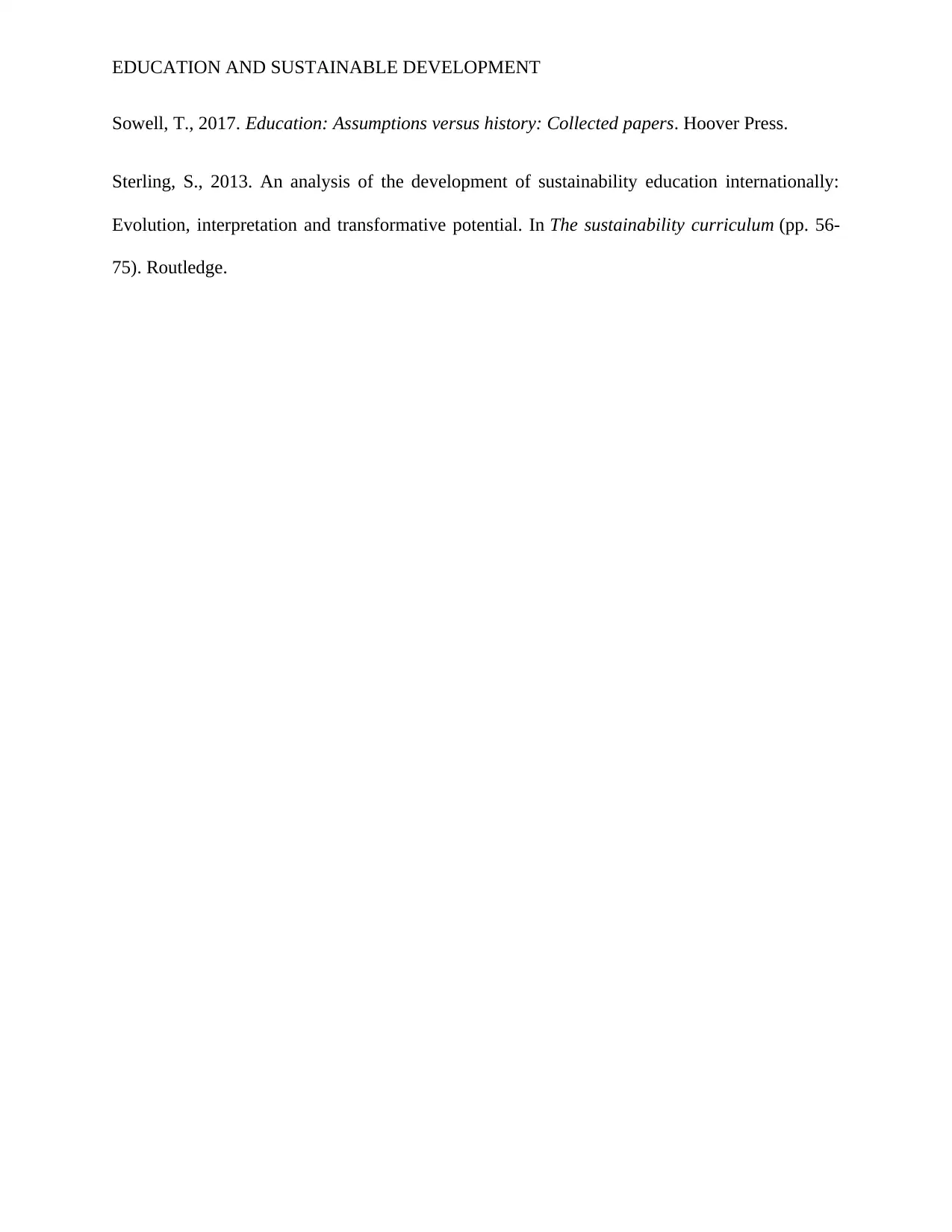
EDUCATION AND SUSTAINABLE DEVELOPMENT
Sowell, T., 2017. Education: Assumptions versus history: Collected papers. Hoover Press.
Sterling, S., 2013. An analysis of the development of sustainability education internationally:
Evolution, interpretation and transformative potential. In The sustainability curriculum (pp. 56-
75). Routledge.
Sowell, T., 2017. Education: Assumptions versus history: Collected papers. Hoover Press.
Sterling, S., 2013. An analysis of the development of sustainability education internationally:
Evolution, interpretation and transformative potential. In The sustainability curriculum (pp. 56-
75). Routledge.
1 out of 16
Related Documents
Your All-in-One AI-Powered Toolkit for Academic Success.
+13062052269
info@desklib.com
Available 24*7 on WhatsApp / Email
![[object Object]](/_next/static/media/star-bottom.7253800d.svg)
Unlock your academic potential
© 2024 | Zucol Services PVT LTD | All rights reserved.





